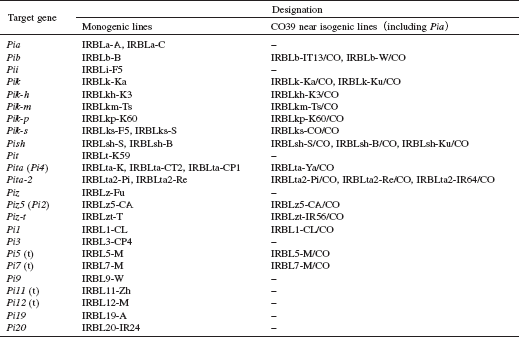Development of new international standard differential variety series to integrate blast resistance of rice (Oryza sativa L.)
Description
[Objectives]
Blast is one of serious diseases in rice cultivation, and the differential system using differential varieties based on gene-for-gene theory were applied to identify the pathogenicities of blast races and resistance gene(s) of rice in a few countries. Unfortunately, there have not been developed the differential varieties which covered a lot of resistance genes and could use in all temperate and tropical areas. To build up the differential system in all countries, IRRI-Japan Collaborative Research Project (IRRI-Japan Project) has developed some differential varieties' sets, which have been accepted worldwide since 1994.
[Results]
The first international standard differential variety (ISDV) set composed of monogenic lines (MLs) for targeting 24 blast (Pyricularia grisea) resistance genes, was recently developed in rice (Oryza sativa L.) through the IRRI-Japan Project entitled "Physio-genetic studies on yield determination and ecological adaptability for sustainable agriculture". Additionally, new ISDVs, near isogenic lines (NILs), for targeting 14 blast resistance genes having an Indica-type rice CO39 genetic background were also developed. CO39 NILs are the first ISDVs for Indica-type rice. Two other kinds of differential variety sets, NILs with Chinese Japonica-type susceptible variety Lijiangxintuanheigu (LTH) and US-2 genetic backgrounds are also being developed. These ISDVs will be available worldwide, for use in pathological analysis of blast races and as the gene sources of resistance genes in breeding programs.
MLs were developed by several backcrosses between donor varieties of resistance gene and LTH as a recurrent parent. MLs including only a single gene in each genetic background targeting for 24 kinds of genes, e.g., Pia, Pib, Pii, Pik-s, Pik, Pik-h, Pik-m, Pik-p, Pish, Pit, Pita (Pi4), Pita-2, Piz, Piz-5 (Pi2), Piz-t, Pi1, Pi-3, Pi5, Pi7(t), Pi9, Pi11(t), Pi12(t), Pi19, and Pi20. These lines have already been distributed to more than 15 countries and have been used in pathogenic analysis and rice breeding as sources of resistance genes under the IRRI-Japan Project.
The other three NILs were backcrossed at least six times with recurrent parents, LTH, CO39, and a highyield type rice US-2. In each backcrossed and selfed generation, the resistant plants with targeted genes were selected using avirulent isolates. Inoculation and selection of resistance genes were continued from BCnF4 to BCnF11 in order to purify the lines and fix their morphological traits. A total of 31 NILs for targeting 14 kinds of resistance genes - Pib, Pik-s, Pik, Pik-h, Pik-m, Pik-p, Pi1, Pi7(t), Pish, Pita, Pita-2, Piz-5, Piz-t and Pi5(t) - were developed and characterized. Each NIL harbored only the major target gene for resistance with the exception of Pia, as confirmed by the stability of their reaction patterns of monogenic lines to standard isolates. In addition, each NIL was very similar to recurrent parent CO39 in morphological terms. Among them, 21 NILs will be made available as a new set of ISDVs having Indica-type genetic background.
The other two kinds of NILs having two genetic backgrounds, LTH and US-2, are being developed as the targets of 17 and 16 resistant genes, respectively. However, it is necessary to generate and select fixed lines within each line, because segregation of some morphological traits were still observed in LTH NILs. In US-2 NILs, several lines will be backcrossed one or two more times and the selection and fixation for resistance and morphological traits will be continued until at least the F9 generation. The designation and target resistance genes of developed monogenic lines and CO39 NILs are shown in Table 1. Monogenic lines and NILs are labeled as IRBL, which is followed by the type of resistance gene and an abbreviation of the donor variety having the initials of the recurrent parent.
Figure, table
-
Table 1. New international standard differential variety series used to evaluate rice blast resistance.
- Affiliation
-
Japan International Research Center for Agricultural Sciences Biological Resources Division
- Classification
-
Technical A
- Term of research
-
FY2003 (FY1994-2004)
- Responsible researcher
-
FUKUTA Yoshimichi ( International Rice Research Institute )
ARAKI Etsuko ( National Agricultural Research Center for Western Region )
TSUNEMATSU Hiroshi ( Biological Resources Division )
KATO Hiroshi ( Miyazaki Prefectural Agricultural Research Institute )
IMBE Tokio ( Institute of Crop Science, NARO )
YANORIA Mary Jeanie Telebenco ( International Rice Research Institute )
Ebron Leodegario A. ( International Rice Research Institute )
KHUSH Gurdev G. ( International Rice Research Institute )
- ほか
- Publication, etc.
-
Fukuta, Y., Araki, E., Yanoria, M.J.T., Imbe, T., Tsunematsu, H., Kato, H., Ebron, L.A., Mercado-Escueta, D. and Khush, G.S. (2004): Development of differential varieties for blast resistance in IRRI-Japan Collaborative Research Project. Rice Blast: Interaction with Rice and Control. Proceeding of the 3rd International Rice Blast Conference. ed. Shinji Kawasaki, Kluwer Accdemic, Netherlamds, 229–233.
Tsunematsu, H., Yanoria, M.J.T., Ebron, L.A., Hayashi, N., Ando, I., Kato, H., Imbe, T. and Khush, G.S. (2000): Development of monogenic lines of rice for blast resistance. Breed. Sci., 50, 229–234.
Tsunematsu, H., Yanoria, M.J.T., Ebron, L.A., Hayashi, N., Ando, I., Mercado-Escueta, D., Kato, H., Fukuta, Y.H. and Imbe, T. (2003): Developing near-isogenic lines for rice blast resistance. Advances in Rice Genetics, 39– 41.
Yanoria, M.J., Fukuta, Y., Imbe, T., Tsunematsu, H., Ban, T., Escuta, D., Ebron, L., Araki, E. and Khush, G.S. (2004): The first of Indica type differntial variety for blast resistance in rice (Oryza sativa L.). World Rice Research Conference abstruct, 353.
- Japanese PDF
-
2003_08_A3_ja.pdf2.31 MB
- English PDF
-
2003_08_A4_en.pdf52.1 KB

